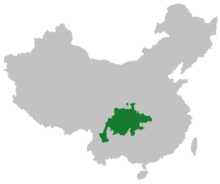Ba-Shu Chinese
| Ba-Shu Chinese | |
|---|---|
| 巴蜀語 | |
| Native to | China |
| Region | Sichuan and Chongqing |
| Extinct | Extinct during the Ming dynasty. Some features are preserved in Sichuanese Mandarin, especially Minjiang dialect. |
| Language codes | |
| ISO 639-3 |
None (mis) |
| Glottolog | None |
Ba-Shu Chinese (Chinese: 巴蜀語; pinyin: Bāshǔ yǔ; Wade–Giles: Ba1 Shu3 Yü3; Sichuanese Pinyin: Ba¹su²yu³; IPA: [pa˥su˨˩y˥˧]), or Old Sichuanese (or Old Szechwanese; Chinese: 蜀語), is an extinct Sinitic language formerly spoken in what is now Sichuan and Chongqing, China. This language is first attested during the Western Han dynasty (206 BCE–8 CE) and represents one of the earliest splits from Old Chinese or Early Middle Chinese. It became extinct during the Ming dynasty, when it was supplanted by Southwestern Mandarin after settlement by people from other parts of China.
Phonological aspects of Ba-Shu Chinese are preserved in the Minjiang dialect of Sichuanese Mandarin.[1][2]
See also
References
This article is issued from Wikipedia - version of the 8/24/2016. The text is available under the Creative Commons Attribution/Share Alike but additional terms may apply for the media files.
